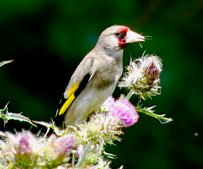|
||||||||||||||||
Carduelis carduelis |
The goldfinch,
one of the most colourful songbirds, is my personal favourite , this
bird can be found throughout Europe, with the exception of the far
north. At nesting time in spring they are seldom to be seen. The goldfinch
is extremely cautious, is a master at hiding himself, and only his
song gives him away occasionally. The nest, which the female builds,
is just as well hidden and camouflaged, so that predators only seldom
find and plunder it. The female works lichen, leaves, and spruce or
pine needles, into the outer layer of the nest and it matches the surroundings.
In gardens the goldfinch prefers to build her nest in apple or cherry
trees, in parks in maple or poplar trees. Breeding and Care: 1,20 m deep, and 2m high by
1m wide. The aviary should be about half enclosed, so that the birds
are protected from wind and rain, and as well as on hot days, provide
shade. In the enclosed portion, a nest should be available such as
a canary basket, or on a block of wood (nistklotz). So that the birds
feel even safer, it should be densely surrounded with evergreen branches
and twigs. Take care however, that observation of the nest and banding
of the baby birds is still possible. As nest material I use horsehair,
sisal, and coconut fiber, as well as plant silk from thistle, dandelion,
and Scharpie. If the pair accepts each other, then they will start
soon with the building of the nest, and finally the egg laying begins.
After about 12 days the chicks hatch. The parents should be given a
wide variety of fresh seed, even before the eggs hatch. For the raising
of the young, live food is necessary in the form of aphids, freshly
flayed mealworms, ant larvae, or pinkies. I have also had success with
some commercial products. Usually after five days, the young will also
be fed by the male. Then the female can leave the nest more frequently,
having up to this point left the nest only to relieve herself and drink.
Banding should take place 5 days after hatching. After about 14 days,
the young birds leave the nest, and are cared for by only one parent
as the second brood is often already started. It is important that
during this stressful time a wide variety of food and mineral supplements
are always available. There are color mutations
known to the golfinch (subspecies major: Achat, Isabell, yellow and
satin). |
||
 |
 |
 |
7-10
million breeding pairs ubiquitous across Europe and southern Scandinavia. Population in Germany: 300.000 - 600.000 constantly Source ©BirdGuides 2001 and NABU |
 |






